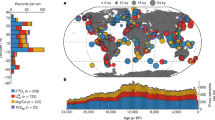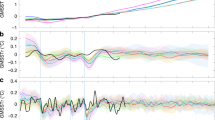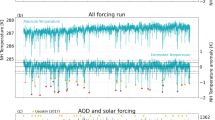Abstract
The Earth’s climate system is driven by a complex interplay of internal chaotic dynamics and natural and anthropogenic external forcing. Recent instrumental data have shown a remarkable degree of asynchronicity between Northern Hemisphere and Southern Hemisphere temperature fluctuations, thereby questioning the relative importance of internal versus external drivers of past as well as future climate variability1,2,3. However, large-scale temperature reconstructions for the past millennium have focused on the Northern Hemisphere4,5, limiting empirical assessments of inter-hemispheric variability on multi-decadal to centennial timescales. Here, we introduce a new millennial ensemble reconstruction of annually resolved temperature variations for the Southern Hemisphere based on an unprecedented network of terrestrial and oceanic palaeoclimate proxy records. In conjunction with an independent Northern Hemisphere temperature reconstruction ensemble5, this record reveals an extended cold period (1594–1677) in both hemispheres but no globally coherent warm phase during the pre-industrial (1000–1850) era. The current (post-1974) warm phase is the only period of the past millennium where both hemispheres are likely to have experienced contemporaneous warm extremes. Our analysis of inter-hemispheric temperature variability in an ensemble of climate model simulations for the past millennium suggests that models tend to overemphasize Northern Hemisphere–Southern Hemisphere synchronicity by underestimating the role of internal ocean–atmosphere dynamics, particularly in the ocean-dominated Southern Hemisphere. Our results imply that climate system predictability on decadal to century timescales may be lower than expected based on assessments of external climate forcing and Northern Hemisphere temperature variations5,6 alone.
This is a preview of subscription content, access via your institution
Access options
Subscribe to this journal
Receive 12 print issues and online access
$209.00 per year
only $17.42 per issue
Buy this article
- Purchase on Springer Link
- Instant access to full article PDF
Prices may be subject to local taxes which are calculated during checkout




Similar content being viewed by others
References
Deser, C., Knutti, R., Solomon, S. & Phillips, A. S. Communication of the role of natural variability in future North American climate. Nature Clim. Change 2, 775–779 (2012).
Thompson, D. W. J., Wallace, J. M., Kennedy, J. J. & Jones, P. D. An abrupt drop in Northern Hemisphere sea surface temperature around 1970. Nature 467, 444–447 (2010).
Friedmann, A., Hwang, Y., Chiang, J. & Frierson, D. Interhemispheric temperature asymmetry over the 20th century and in future projections. J. Clim. 26, 5419–5433 (2013).
Mann, M. et al. Proxy-based reconstructions of hemispheric and global surface temperature variations over the past two millennia. Proc. Natl Acad. Sci. USA 105, 13252–13257 (2008).
Frank, D. C. et al. Ensemble reconstruction constraints on the global carbon cycle sensitivity to climate. Nature 463, 527–532 (2010).
Hegerl, G. C., Crowley, T. J., Hyde, W. T. & Frame, D. J. Climate sensitivity constrained by temperature reconstructions over the past seven centuries. Nature 440, 1029–1032 (2006).
Frank, D., Esper, J., Zorita, E. & Wilson, R. A noodle, hockey stick, and spaghetti plate: A perspective on high-resolution paleoclimatology. WIREs Clim. Change 1, 507–516 (2010).
Jones, P. D., Briffa, K. R., Barnett, T. P. & Tett, S. F. B. High-resolution palaeoclimatic records for the last millennium: Interpretation, integration and comparison with General Circulation Model control-run temperatures. Holocene 8, 455–471 (1998).
Mann, M. E. & Jones, P. D. Global surface temperatures over the past two millennia. Geophys. Res. Lett. 30, 1820 (2003).
Hegerl, G. et al. Detection of human influence on a new, validated 1500-year temperature reconstruction. J. Clim. 20, 650–666 (2007).
Goosse, H. et al. The role of forcing and internal dynamics in explaining the “Medieval Climate Anomaly”. Clim. Dynam. 39, 2847–2866 (2012).
WAIS Divide Project Members, Onset of deglacial warming in West Antarctica driven by local orbital forcing. Nature 500, 440–444 (2013).
Shakun, J. D. et al. Global warming preceded by increasing carbon dioxide concentrations during the last deglaciation. Nature 484, 49–54 (2012).
PAGES 2k Consortium, Continental-scale temperature variability during the past two millennia. Nature Geosci. 6, 339–346 (2013).
Neukom, R. & Gergis, J. Southern Hemisphere high-resolution palaeoclimate records of the last 2000 years. Holocene 22, 501–524 (2012).
Fernández-Donado, L. et al. Large-scale temperature response to external forcing in simulations and reconstructions of the last millennium. Clim. Past 9, 393–421 (2013).
Stouffer, R. J., Manabe, S. & Bryan, K. Interhemispheric asymmetry in climate response to a gradual increase of atmospheric CO2 . Nature 342, 660–662 (1989).
Goosse, H. et al. A late medieval warm period in the Southern Ocean as a delayed response to external forcing? Geophys. Res. Lett. 31, L06203 (2004).
MacFarling–Meure, C. et al. Law Dome CO2, CH4 and N2O ice core records extended to 2000 years BP. Geophys. Res. Lett. 33, L14810 (2006).
Jungclaus, J. H. et al. Climate and carbon-cycle variability over the last millennium. Clim. Past 6, 723–737 (2010).
Pongratz, J., Caldeira, K., Reick, C. H. & Claussen, M. Coupled climate-carbon simulations indicate minor global effects of wars and epidemics on atmospheric CO2 between AD 800 and 1850. Holocene 21, 843–851 (2011).
Wahl, E. R. & Smerdon, J. E. Comparative performance of paleoclimate field and index reconstructions derived from climate proxies and noise-only predictors. Geophys. Res. Lett. 39, L06703 (2012).
Neukom, R. et al. Multiproxy summer and winter surface air temperature field reconstructions for southern South America covering the past centuries. Clim. Dynam. 37, 35–51 (2011).
Schaefer, J. M. et al. High-frequency holocene glacier fluctuations in New Zealand differ from the northern signature. Science 324, 622–625 (2009).
González-Rouco, F. J. et al. Medieval Climate Anomaly to Little Ice Age transition as simulated by current climate models. PAGES News 19, 7–8 (2011).
Miller, G. H. et al. Abrupt onset of the Little Ice Age triggered by volcanism and sustained by sea-ice/ocean feedbacks. Geophys. Res. Lett. 39, L02708 (2012).
Braconnot, P. et al. Evaluation of climate models using palaeoclimatic data. Nature Clim. Change 2, 417–424 (2012).
Hansen, J., Ruedy, R., Sato, M. & Lo, K. Global surface temperature change. Rev. Geophys. 48, RG4004 (2010).
Crowley, T. J. et al. Volcanism and the Little Ice Age. PAGES News 16, 22–23 (2008).
Steinhilber, F., Beer, J. & Fröhlich, C. Total solar irradiance during the Holocene. Geophys. Res. Lett. 36, L19704 (2009).
Acknowledgements
This work has been possible thanks to the collaboration of many members of the Australasian, South American, African and Antarctic working groups of the PAGES Regional 2K initiative. Researchers from these working groups are warmly thanked for providing metadata inventories and access to data. S. J. Phipps is acknowledged for support with model data. We acknowledge funding from the Swiss National Science Foundation and funding from the Australian Research Council (Projects LP0990151 and DE130100668) and the Australian Department of Climate Change and Energy Efficiency.
Author information
Authors and Affiliations
Contributions
R.N. performed data analyses and developed the figures and tables. R.N., D.F. and J.G. led the writing of the paper. R.N., J.G., D.J.K., H.W. and D.F. designed the study. M.C., J.E., B.K.L, A.D.M., I.M., E.J.S., T.V., R.V., T.v.O. and J.Z. assisted with proxy data and F.G. and C.C.R. with climate model data. All authors discussed the results and commented jointly on the manuscript.
Corresponding author
Ethics declarations
Competing interests
The authors declare no competing financial interests.
Supplementary information
Rights and permissions
About this article
Cite this article
Neukom, R., Gergis, J., Karoly, D. et al. Inter-hemispheric temperature variability over the past millennium. Nature Clim Change 4, 362–367 (2014). https://doi.org/10.1038/nclimate2174
Received:
Accepted:
Published:
Issue Date:
DOI: https://doi.org/10.1038/nclimate2174
This article is cited by
-
Attribution of Biases of Interhemispheric Temperature Contrast in CMIP6 Models
Advances in Atmospheric Sciences (2024)
-
Impact of the Tambora volcanic eruption of 1815 on islands and relevance to future sunlight-blocking catastrophes
Scientific Reports (2023)
-
Fennoscandian tree-ring anatomy shows a warmer modern than medieval climate
Nature (2023)
-
Fifty Years Later—The Legacy of Alfred Crosby’s “The Columbian Exchange: Biological and Cultural Consequences of 1492”
Economic Botany (2023)
-
Changes in SST regulate hydroclimatic patterns in the monsoon marginal zone, northern China
Climate Dynamics (2023)



